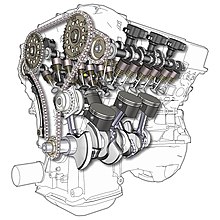User:Cuyamas/Piston engine layout

An internal combustion piston engine's layout describes the number and arrangement of cylinders in an engine. Engines with more than one cylinder have those cylinders arranged in one or more banks, which are evenly spaced rows of cylinders along the same axis. Engines with multiple cylinder banks will often have single cylinder heads for each bank of pistons.
Engine layout is independent of other descriptions of a type of piston engine, such as use, fuel type, displacement, and the number and position of valves and camshafts.
Design considerations of different layouts
[edit]Displacement and cylinder count
[edit]Packaging
[edit]All else the same, an inline 4 cylinder engine will be relatively tall and narrow, while a boxer 4 cylinder engine will be relatively wide and flat. While these two different engines might be similar or identical in terms of weight and power output, the difference in their shapes may cause one or the other to be better suited to a particular application.
Engine balance and vibration
[edit]Airflow
[edit]While liquid cooled engines are able to regular their temperature via heat exchange through coolant and a radiator, air cooled engines are dependent on air flow around the cylinders themselves to provide cooling. Multiple bank layouts, and especially boxer and radial engines, are generally preferred relative to inline engines in air cooled use cases due to their relatively larger front cross section area, which results in more efficient air cooling.
This principle can be seen with the popularity of air cooled radial aircraft engines in the early 20th century, Lycoming O-series boxer engines which power several of the most widely produced aircraft of all time, and in multiple generations of the popular Porsche 911 sports car.
Engine layout categories
[edit]Single cylinder bank layouts
[edit]Single cylinder engines are
Inline 2, 3, 4, and 6 cylinder engines are very common across a wide range of applications. Inline engines with more than six cylinders are uncommon. Inline 8 cylinder engines were relatively common in automotive use during the early 20th century, and some large maritime vessels are powered by inline engines with as many as 14 cylinders.
V pattern engines
[edit]V pattern engines are engines with 2 cylinder banks, and which Several companies, namely Volkswagen and Lancia, have produced V engines for automotive use which are notable for having very narrow (less than 20°) bank angles, as well as having a single cylinder head shared by their two banks of cylinders. Volkswagen refers to these as VR engines.
Several companies, namely Volkswagen and Lancia, have produced V engines for automotive use which are notable for having very narrow (less than 20°) bank angles, as well as having a single cylinder head shared by their two banks of cylinders. Volkswagen refers to these as VR engines.
Layouts with more than two cylinder banks
[edit]Historically, radial engines are the most common
Multiple crankshaft layouts
[edit]Incomplete rough draft
